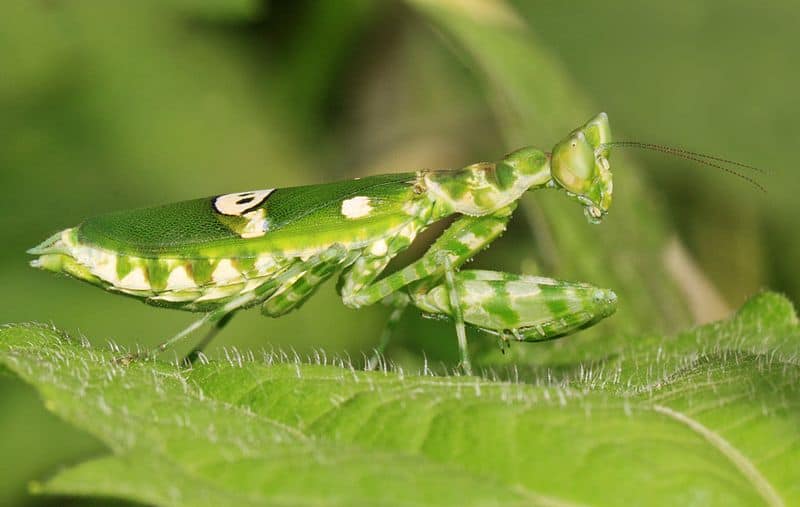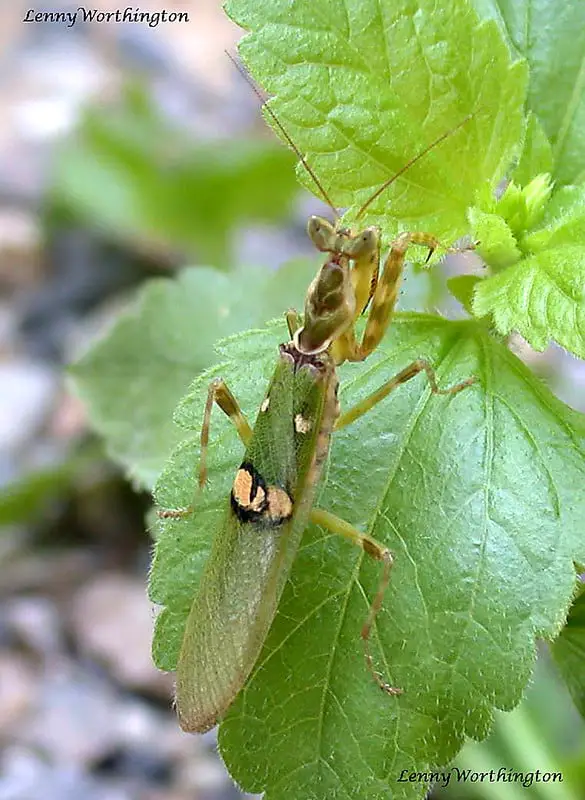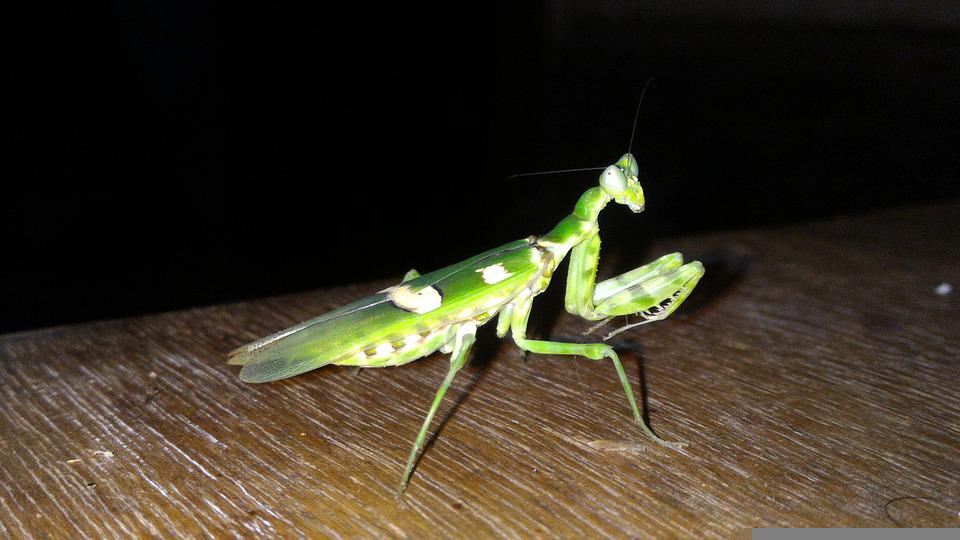The Indian Flower Mantis (Creobroter pictipennis) is a beautiful tiny mantis that makes for a fantastic pet. It’s famous in the insect-keeping hobby for having a unique appearance that gets showcased every time it takes a threat posture.
If you’re interested in getting the beautiful and fun Indian Flower Mantis for your collection, here’s everything you need to know about them.

Indian Flower Mantis Care Sheet
| Name of species | Creobroter pictipennis |
| Family | Mantidae |
| Common name | Budwing Mantis |
| Type | Macropterous |
| Native location | Asia |
| Temperature | 70°F to 85°F |
| Humidity | 60% and 80% |
| Size | 1.5 to 1.8 inches (3 to 7 cm) |
| Diet | Small insects |
| Lifespan | 9 months |
| Experience level | Beginner |
Indian Flower Mantis Overview

The Creobroter pictipennis is commonly known as Indian Flower Mantis or Asian Flower Mantis. It can be found in Asia, particularly in tropical climates such as India.
It’s a macropterous mantis, which means it has long wings that allow it to fly. It’s also classified as a flower mantis thanks to its camouflage patterns that make it resemble a flower. It’s happy eating small insects such as flies and mealworms, so it’s easy to feed.
Appearance
The Indian Flower Mantis is a relatively small insect with a creamy-white color and beautiful, long, and unique wings. Its light color is topped with brown and yellow stripes on its legs and blotches over its upper abdomen.
The wings have a striking yellow circle that characterizes the Creobroter genus. If you’ve ever seen one of these amazing mantids in a threat posture, you’ll recognize it by the yellow “eyes” that lay over its wings.
Like all mantids, the Indian Flower Mantis exhibits sexual dimorphism. The female specimens are bulkier and bigger than the males. Males also have thicker antennae.
On average, they reach a fully grown size of between 1.5 to 1.8 inches.
Price
The Indian Flower Mantis isn’t as readily available as other mantids in exotic pet stores; however, their price isn’t too high in spite of its low availability.
You’ll find nymphs for around $30 and adult specimens for $40. Getting several specimens is advisable if you’re interested in breeding them.
You should also pick nymphs over adults if you’re experienced enough to care for them during this vulnerable time because then you’ll be able to experience their entire lifecycle from nymph to adult.
Behavior and Temperament
The Indian Flower Mantis is an active predator that will chase its prey instead of waiting for it to get close. Cannibalism can also happen, as it’s common among mantids, so you shouldn’t house more than one adult specimen in the same enclosure.
The Indian Flower Mantis’ active-hunting behavior is complemented by its interesting behavior toward what it perceives as threats. Of course, in captivity, they will not face any predators, but humans can be intimidating for mantids. If they’re scared, they will first attempt to flee. They’re fast fliers and will attempt to fly away from predators if they have a chance.
However, if they’re cornered, they’ll attempt to scare away the predator by assuming a threat posture and displaying its colors; this beautiful display makes the Indian Flower Mantis an interesting pet.
Males are more likely to try to fly away from threats than females, so be careful to keep them from escaping or crashing into dangerous objects such as ceiling fans if you’re looking to handle them.
Caring for an Indian Flower Mantis

Temperature and Humidity
The Indian Flower Mantis lives in hot climates with high humidity. It’s most comfortable at temperatures around 75°F, but it can live happily between 70°F and 85°F.
As for humidity, you should keep your Indian Flower Mantis between 60% and 80%, which can only be achieved through frequent misting of the enclosure.
Substrate
The Indian Flower Mantis needs a type of substrate that has good moisture retention.
Mixtures with peat moss should be your first choice, adding healthy organic soil if you’re looking for a living vivarium.
As for the depth, one to two inches of substrate are going to be enough for your mantis as it doesn’t burrow.
Tank
The Indian Flower Mantis needs an enclosure that’s at least three times as long, two times as wide, and two times as tall as the mantis.
Since this is a small mantis, finding a tank that’s at least that big, and even going overhead for the mantis’ comfort, is an achievable goal.
This species’ enclosure needs good ventilation to prevent mold and bacterial growth, so make sure the tank has enough ventilation holes to keep it healthy.
The Creobroter pictipennis needs to hang upside down during molting, so a twig or branch is needed as decoration so it can grow comfortably.
Other decorative items such as fake plants are a plus, but they’re unnecessary unless you’re going for a living vivarium. Keeping the mantis in a living biome is beneficial as it thrives around living plants and microfauna such as isopods, which act as cleaning crews.
Watering
Your Indian Flower Mantis doesn’t need a water dish as it gets its hydration from food. However, it’ll often drink water drops found lying over the surfaces of the enclosure, so misting is important. Mist the tank with water every other day is also vital to keep the humidity levels optimal for your mantis.
Diet & feeding
The Indian Flower Mantis will happily feed on insects that are small enough to fall on its menu, but it prefers flying insects such as flies.
L1 and L2 nymphs can be fed with small fruit flies such as D. melanogasters.
L3 and L4 nymphs can eat bigger fruit flies such as D. hydei every two or three days.
L5 to adults can eat larger flies like blue bottle flies and house flies.
If you have your mantis in a bioactive enclosure with cleaning microfauna, this will take care of any remains left by the mantis. If not, make sure to clean any remains left by your mantis to avoid bacteria and fungi proliferation. Feed your mantis until it’s satisfied but be mindful of its abdomen; if it gets bulkier, it means you’re overfeeding it, and you should adjust its diet accordingly.
Social
The Indian Flower Mantis is not a communal species. You should not attempt to house more than one of these mantids in a single enclosure because this will likely result in cannibalism.
If you want a communal setup, only do so with species that are capable of living communally like the Ghost Mantis.
Health & Lifespan
The Indian Flower Mantis has a lifespan of around 9 months, which is not very long. In captivity, they can easily reach their full lifespan as long as you keep them in optimal conditions and feed them well.
Breeding the Indian Flower Mantis
If you want to breed the Indian Flower Mantis you will first have to select a male and a female. About 2 to 4 weeks after the final molt, you can attempt to start the breeding.
Before you put the male and the female together it’s very important that the female is well-fed. Ideally, you’d introduce the male while the female is eating. That way, there’s a lower chance of the male being eaten.
If you’ve introduced them safely the mating process can take a couple of hours. Once the mating process has been completed successfully it’s essential that you remove the male to avoid him being eaten alive.
After a successful mate, the female will lay an ootheca. Keep this ootheca in the same conditions as the mantis but be very careful to prevent mold. Mold is extremely deadly for ootheca. The eggs in the ootheca will hatch after a while and 20 to 35 nymphs will be born.
Indian Flower Mantis Facts
- The circles displayed over the Indian Flower Mantis’ wings are most likely supposed to resemble animal eyes, therefore tricking their predators into believing that they’re in front of a much bigger specimen. However, through our perception, these mantids look like they have small and cartoonish faces drawn over their wings, making them much more beautiful and adorable.
- There are many other members of the Creobroter genus that share similar characteristics with the Creobroter pictipennis. Out of all similar species, the Creobroter gemmatus and the Creobroter nebulosa are the only other ones that are kept as a pet. Since these species are so similar, it’s alright to use the information displayed in this article to care for C. gemmatus and C. nebulosa.
- The Indian Flower Mantis or Asian Flower Mantis spends most of its time lying still, so you’d think it hunts by ambush like other mantids. However, as soon as it sees a possible prey, it gives chase, making for an interesting feeding response every time you provide it with food.
Final words
The Indian Flower Mantis is a famous and beautiful species that should be in every hobbyist’s collection. It’s beautiful, fun to look at, and easy to take care of. Its only downside is its relatively short lifespan. Nevertheless, despite the fact that they do not live particularly long the short time that they are with you will be unforgettable!
If after reading this you decide that this species is not for you, you might want to check out the Dead Leaf or Orchid Mantis instead.
- How Long Do American Eskimo Dogs Live? Important Factors and Care Tips - September 29, 2023
- Do American Bulldogs Need Grooming? Essential Tips and Care Guidelines - September 29, 2023
- Do Bengal Cats Enjoy Playing? Essential Tips for Keeping Them Active - September 29, 2023